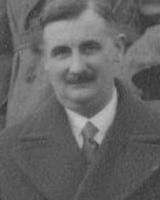Georg Prange
Georg Heinrich Friedrich Wilhelm Prange (born January 1, 1885 in Hanover ; † February 3, 1941 there ) was a German applied mathematician .
Life
Prange was the son of a businessman who came from a simple farming background and had worked his way up in Hanover. From 1903 Prange studied at the University of Göttingen with Felix Klein and David Hilbert, among others . After two semesters in Munich he returned to Göttingen, but had to break off his studies due to the outbreak of a lung disease from which he almost died. He was only able to continue studying in 1910. In 1912 he passed his teaching examination in Göttingen and became an assistant at the Technical University in Hanover with Conrad Müller . In 1914 he received his doctorate in Göttingen under Hilbert with a thesis on the Hamilton principle of mechanics ( The Hamilton-Jacobi theory for double integrals ). In his habilitation, supervised by Conrad Müller, he dealt with the fundamentals of the variation methods in elasticity theory. He also examined William Rowan Hamilton's work on geometrical optics and its role in the origin of Hamilton's treatment of mechanics. His translations of Hamilton's work were supported by the Zeiss company .
After a few months as a lecturer in Halle, he became professor for higher mathematics in 1921 with a teaching assignment for applied mathematics at the TH Hannover. In Hanover he gave lectures on mathematical methods in electrical engineering. Most recently, he dealt with the three-body problem following the work of Henri Poincaré and George David Birkhoff . After 1921 Prange received three calls, to Brno, Dresden and Karlsruhe, all of which he declined. He kept the position as professor of mathematics at the TH Hannover until his death. He died at the age of 56 in Hanover.
In his habilitation, he demonstrated the equivalence of force measurement methods and displacement measurement methods in structural engineering. According to Prange, both emerge from each other through a Legendre transformation (they are dual to one another) in the variation problem of deformation work or potential energy. Before that there was a dispute between the leading German structural engineers Christian Otto Mohr (path size method, deformation method) and Heinrich Müller-Breslau (force size method). Both methods were developed for the practical calculation of framework structures. This was ignored for a long time by civil engineers interested in practical applications, at that time the force measurement method was mostly used (with the forces as a variable), the deformation method only experienced its boom with the advent of the finite elements in statics, where it usually forms the methodological basis .
In 1927 he was elected a member of the Leopoldina .
Fonts
- with Conrad Müller Applied Mechanics , Hanover, Helwingsche Verlagsbuchhandlung, 1923
- Lectures on integral and differential calculus , 2 volumes, Springer Verlag 1943
- Prange The general integration methods of analytical mechanics , Encyclopedia of the Mathematical Sciences 1933
- Prange Das Extremum der Formwandungsarbeit, habilitation thesis Technische Hochschule Hannover, 1916, edited and introduced by Klaus Knothe , series Algorism, issue 31, Institute for the History of Natural Sciences Munich 1999
- Prange "The Theory of the Beam in Technical Elasticity", Journal for Architecture and Engineering, New Volume 24: 84 - 96, 121 - 150 , 1919
- The Hamilton-Jacobi theory for double integrals , dissertation 1915
- Hamilton's Contribution to Geometric Optics , DMV Annual Report
- WR Hamilton's treatises on radiation optics , Leipzig, Akademische Verlagsgesellschaft 1933
literature
- Dorit Petschel : 175 years of TU Dresden. Volume 3: The professors of the TU Dresden 1828–2003. Edited on behalf of the Society of Friends and Supporters of the TU Dresden e. V. von Reiner Pommerin , Böhlau, Cologne a. a. 2003, ISBN 3-412-02503-8 , pp. 732-733.
- Karl-Eugen Kurrer : The History of the Theory of Structures. Searching for Equilibrium , Ernst & Sohn 2018, p. 846f, p. 891ff, 896f and p. 1048f. (Biography), ISBN 978-3-433-03229-9 .
- TH Hannover (ed.): The faculty of the Technical University of Hanover 1831–1956, Hannover: TH Hannover 1956, p. 10.
Web links
Individual evidence
- ↑ Prange, Das Extremum der Formänderungsarbeit, TH Hannover 1916. Published as: Prange, Theory of the beam in technical elasticity, Journal for Architecture and Engineering, Volume 65, 1919, pp. 83–96, 121–150
- ↑ Klaus Knothe , Force size method and deformation method in the light of Georg Prange's habilitation thesis (1885–1941), Stahlbau, Volume 84, 2015, Issue 5, pp. 34–346
| personal data | |
|---|---|
| SURNAME | Prange, Georg |
| ALTERNATIVE NAMES | Prange, Georg Heinrich Friedrich Wilhelm |
| BRIEF DESCRIPTION | German applied mathematician |
| DATE OF BIRTH | January 1, 1885 |
| PLACE OF BIRTH | Hanover |
| DATE OF DEATH | February 3, 1941 |
| Place of death | Hanover |
